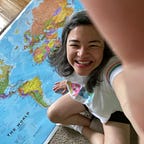Lake Titicaca, the Highest Navigated lake in the World!
Lake Titicaca has been and continues to be a sacred space for many of the natives people of Bolivia and Peru as they believe that Manco Capac, the first Inca king, was born in an island on this lake. Manco Capac is the founding father of the Incas.
Nestled between Bolivia and Peru, Lake TIticaca is 12,500 feet (3,810 metres) above sea level is located in a high flat area called the “Antiplano” or antiplane in the Andes Mountain Range. Some figures of size and height: It covers some 3,200 square miles (8,300 square km) and extends in a northwest-to-southeast direction for a distance of 120 miles (190 km). It is 50 miles (80 km) across at its widest point. This is a satelite view:
This lake is the highest in the world navigated by big vessels. The lake averages between 460 and 600 feet (140 and 180 metres) in depth, but the bottom tilts sharply toward the Bolivian shore, reaching its greatest recorded depth of 920 feet (280 metres) off Isla Soto in the lake’s northeast corner.
This is a view of the lake from the town of Copacavana in Bolivia. This town has about 6,000 inhabitants. Before 1534, Copacabana was an outpost of Inca occupation among dozens of other sites in Bolivia. The Incas held it as the key to the very ancient shrine and oracle on the Island of Titicaca (Isla del Sol), which they had adopted as a place of worship, adopting the veneration with which it was held by the Aymaras from time immemorial. (1)
At Copacabana, there were minor shrines in which the ceremonies of the Incas were observed along with those of the original inhabitants. When the Spaniards first visited the Islands of Titicaca and Loati, in 1534 and 1538, the Andean Cosmovision were abandoned and the Dominicans made Copacabana the centre of their missions.
About 25 rivers empty their waters into Titicaca.The largest is called the Ramis, draining about two-fifths of the entire Titicaca Basin. There is only one river that drains Lake Titicaca,. It’s called “Desaguadero” and it empties about 5 percent of the lake’s excess water. The rest is lost by evaporation under the fierce sun and strong winds of the dry Altiplano.
There are forty-one islands on Titicaca’s waters. The largest, Titicaca Island (Spanish: Isla de Titicaca, also called Isla del Sol), lies just off the tip of the Copacabana Peninsula in Bolivia. It is the most sacred place for many natives people of Bolivia and Peru.
Isla del Sol, Isla de Titicaca
On this island, according to the tradition of the Incas, the legendary founders of the Inca dynasty, Manco Capac and Mama Ocllo, were sent down to Earth by the Sun. (2) This is the exact site on the island:
This is a depiction of Manco Capac by the Cuzco School of Art:
One of the ancient indigenous groups that live around the lake are the Aymara people. They still practice their ancient methods of agriculture on stepped terraces that predate Inca times. They grow barley, quinoa, and the potato, which originated on the Altiplano. The highest cultivated plot in the world was found near Titicaca-a field of barley growing at a height of 15,420 feet (4,700 metres) above sea level. (2)
In the following two photos you can appreciate the terraces for crops on Isla del Sol. They are in Yumani, Isla del Sol:
This is an Inca fountain in Yumani, Isla del Sol:
Isla de Uros
Uros (or Uru) people are one of the ancient peoples to live around this lake since ancient times. They harverst reeds that naturally grow on the lake’s banks. They use these reeds to make the islands by continuously adding reeds to the surface. They live on an approximate and still growing 120 self-fashioned floating islands in Lake Titicaca near Puno. They form three main groups: the Uru-Chipaya, Uru-Murato, and Uru-Iruito. The Uru-Iruito still inhabit the Bolivian side of Lake Titicaca and the Desaguadero River.
These is what their islands and boats look like:
So unique isn’t it? So beautiful and special. I read about their struggles to survive in this lake. At one point they headed way in escaping modern living, but they could not plant enough crops to survive. They had to adapt to the people and live close to the coasts and now many of them survive on tourism. I know this is the way or our world. Still, there is a part in me that feels so sad… I wish their spaces would have been respected, and they could survive the way they used to.
These are some of the souvenirs you can buy there:
If you want to read someone’s blog about visiting Lake Titicaca, go HERE or HERE.
And this is a beautiful video… to feel you are there:
Sources:
(1) Wikipedia
(2) Encyclopedia Britannica
Originally published at http://myvirtualworldtrip.com on July 11, 2021.
